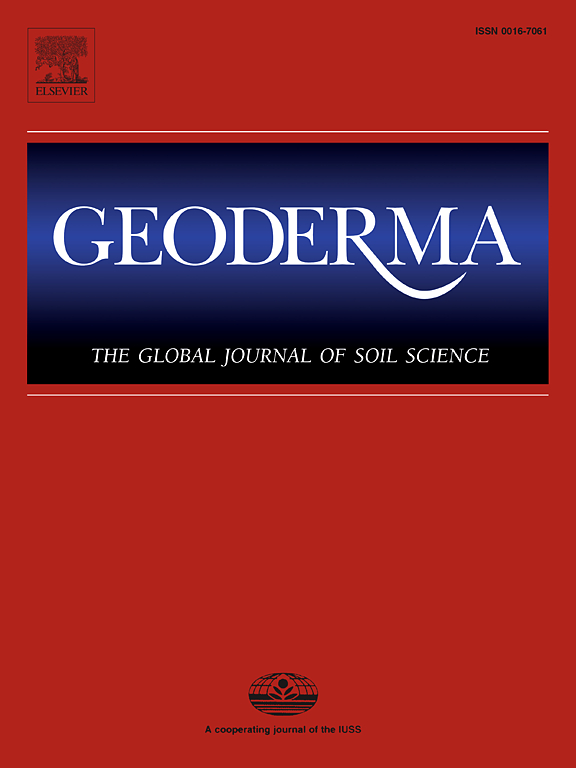Soil structural indicators as predictors of biological activity under various soil management practices
IF 5.6
1区 农林科学
Q1 SOIL SCIENCE
引用次数: 0
Abstract
Soil structure is a key feature in controlling the turnover of organic matter in soils. The spatial arrangement of solids and pores in agricultural topsoil can be actively influenced by management practices, such as tillage and cropping systems, which in turn can affect the resident microbial communities and their activities. However, carbon mineralisation and microbial activity are usually measured in sieved samples, which provides information on gross potentials under optimal conditions. Under these conditions, the spatial heterogeneities that are specific to different management practices are reduced or totally removed. In this study, we combined X-ray computer tomography (X-ray CT) and isothermal calorimetry to investigate the effect of soil structure on heat dissipation, as an indicator of biological activity. Samples were collected from the topsoil of a long-term field experiment (12 years) that included four different land uses: conventional vs. reduced tillage, each with either maize or winter wheat as the main crop in the rotation. We compared the response of undisturbed soil cores (3 cm in height, 2.7 cm in diameter) to the addition of water and glucose in specific pore sizes, ranging in radii of 15 to 75 µm or 3 to 75 µm. The pore structure and indicators of particulate organic material were quantified using X-ray CT with a voxel resolution of 15 µm. This allowed us to distinguish between the effects of crop rotation and tillage regime on biological activity, soil structure and the feedback between the two. Heat dissipation correlated significantly with X-ray CT derived porosity, pore surface density and soil matrix grey value, all of which were affected by both tillage regime and crop rotation. Heat dissipation in maize plots after glucose addition to the pore size range with radii of 3 to 75 µm was greater than in the winter wheat systems, but not when added to the pore size range with radii of 15 to 75 µm. The study showed that structural indicators can explain up to 81 % and 95 % of the variance in total heat dissipation after glucose and water addition, respectively, but only 60 % of the heat dynamics, here defined as the time taken for 50 % of total heat to be dissipated. The results emphasise the importance of soil structure in regulating microbial decomposition of soil organic matter and warrants further investigations.
土壤结构指标作为各种土壤管理措施下生物活性的预测指标
土壤结构是控制土壤有机质周转的关键特征。农业表土中固体和孔隙的空间排列可以受到管理措施的积极影响,例如耕作和种植制度,这反过来又可以影响常驻微生物群落及其活动。然而,碳矿化和微生物活性通常是在筛选的样品中测量的,这提供了在最佳条件下的总电位的信息。在这些条件下,不同管理实践特有的空间异质性被减少或完全消除。在这项研究中,我们结合x射线计算机断层扫描(x射线CT)和等温量热法来研究土壤结构对散热的影响,作为生物活性的指标。从长期田间试验(12年)的表层土壤中收集样本,包括四种不同的土地利用方式:常规耕作与减少耕作,每一种都以玉米或冬小麦作为轮作的主要作物。我们比较了未受干扰的土芯(高3厘米,直径2.7厘米)对特定孔径(半径为15至75微米或3至75微米)中添加水和葡萄糖的反应。采用体素分辨率为15µm的x射线CT对颗粒状有机物的孔隙结构和各项指标进行定量分析。这使我们能够区分轮作和耕作制度对生物活性、土壤结构的影响以及两者之间的反馈。热耗散与x射线CT计算的孔隙率、孔隙表面密度和土壤基质灰色值显著相关,均受耕作制度和作物轮作的影响。在3 ~ 75µm孔径范围内添加葡萄糖后,玉米地块的散热大于冬小麦体系,而在15 ~ 75µm孔径范围内添加葡萄糖则没有。研究表明,结构指标可以分别解释添加葡萄糖和水后总散热变化的81%和95%,但只能解释60%的热动力学,这里定义为总热量消耗50%所需的时间。这些结果强调了土壤结构在调节微生物分解土壤有机质中的重要性,值得进一步研究。
本文章由计算机程序翻译,如有差异,请以英文原文为准。
求助全文
约1分钟内获得全文
求助全文
来源期刊

Geoderma
农林科学-土壤科学
CiteScore
11.80
自引率
6.60%
发文量
597
审稿时长
58 days
期刊介绍:
Geoderma - the global journal of soil science - welcomes authors, readers and soil research from all parts of the world, encourages worldwide soil studies, and embraces all aspects of soil science and its associated pedagogy. The journal particularly welcomes interdisciplinary work focusing on dynamic soil processes and functions across space and time.
 求助内容:
求助内容: 应助结果提醒方式:
应助结果提醒方式:


